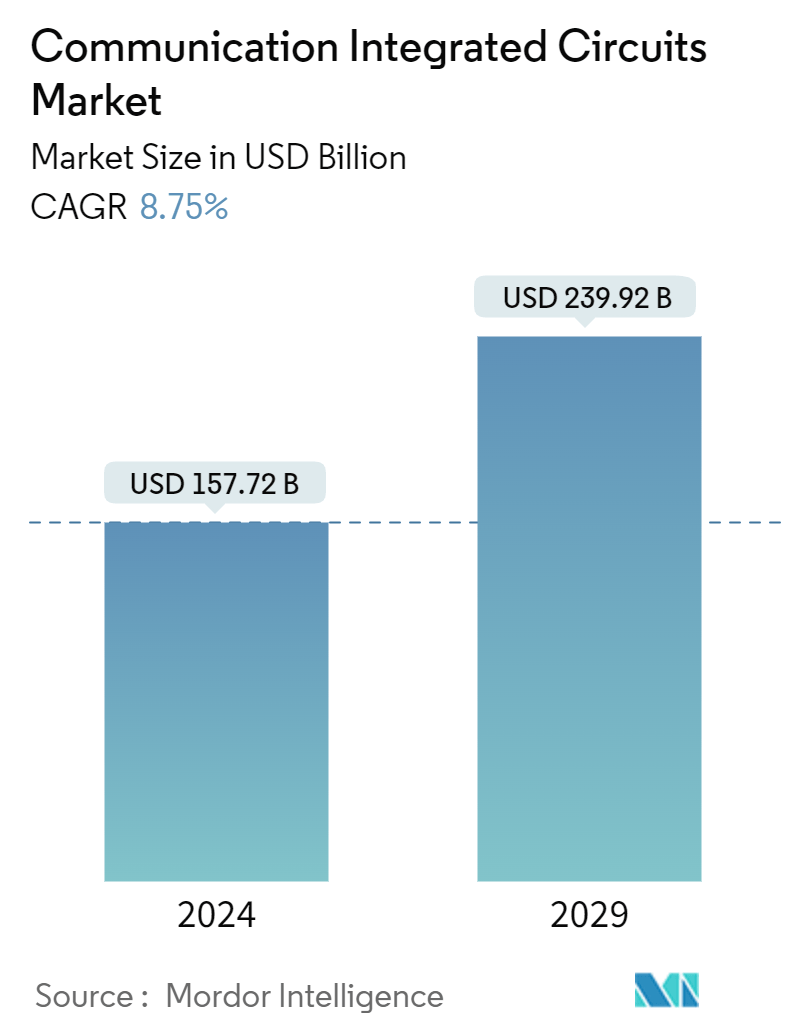Market Size of Communication Integrated Circuits Industry

| Study Period | 2019 - 2029 |
| Base Year For Estimation | 2023 |
| Market Size (2024) | USD 157.72 Billion |
| Market Size (2029) | USD 239.92 Billion |
| CAGR (2024 - 2029) | 8.75 % |
| Market Concentration | Low |
Major Players
*Disclaimer: Major Players sorted in no particular order |
Communication Integrated Circuits Market Analysis
The Communication Integrated Circuits Market size is estimated at USD 157.72 billion in 2024, and is expected to reach USD 239.92 billion by 2029, growing at a CAGR of 8.75% during the forecast period (2024-2029).
- Communication integrated circuits are specialized components utilized in various telecommunication electronic systems, facilitating the transmission, reception, and analysis of data and signals.
- The advancement of integrated circuits has significantly decreased the size, increased the speed, and lowered the cost of computing, thereby facilitating the emergence of compact, portable devices. This progress has contributed to enhancements in processing capabilities, which are in line with Moore's Law, promoted the evolution of digital technologies, and made possible the development of more sophisticated software applications.
- The rising need for data centers is driving an upsurge in the demand for communication ICs. Presently, substantial data center initiatives in North America have led to a robust demand for memory ICs, particularly DRAM. Nevertheless, when evaluating data center space per user, it is projected that China's internet data centers will expand to at least 22 times the capacity of those in the United States or at least 10 times the existing space in Japan. Consequently, DRAM presents a considerable growth opportunity, thereby significantly influencing the communication ICs market.
- Furthermore, several regional governments are actively promoting the adoption of wireless communication technologies, thereby facilitating the expansion of communication ICs. For instance, in May 2024, the National Telecommunications and Information Administration (NTIA), part of the Department of Commerce, announced its intention to allocate a significant sum of USD 420 million for the advancement of radio equipment.
- This funding is specifically designated to enhance the implementation of open networks, both in the United States and internationally. This initiative represents the second Notice of Funding Opportunity (NOFO) issued by the Public Wireless Supply Chain Innovation Fund. The main objective of this NOFO is to stimulate commercialization and encourage innovation in the field of open radio units.
- The growing adoption of 5G worldwide is expected to support market growth. In October 2023, Vodafone Idea announced that it would make significant investments in the deployment of 5G networks as well as expand 4G coverage across India. This commitment, which the company made in line with its determination to promote the government's vision through initiatives such as OpenRAN, has been disclosed at the 7th India Mobile Congress.
- Adding to this, it is anticipated that telecommunications companies and mobile operators are expected to make investments worth more than USD 600 billion in 5G infrastructure. These investment prospects are expected to fuel market growth for communication ICs over the forecast period.
- The advancement and miniaturization of integrated circuits (ICs) have resulted in more complex manufacturing processes. This increased complexity often leads to elevated failure rates during both production and testing stages, negatively impacting yields and overall expenses. Additionally, the design of ICs typically relies on a web of patents and intellectual property rights, adding another layer of intricacy. Organizations must adeptly navigate the risks related to patent infringement and possible legal disputes, as poor management of these matters can severely obstruct market entry and stifle innovation.
- The macroeconomic factors, such as fluctuations in exchange rates and international trade dynamics, might impact the global communication integrated circuits market. Changes in currency values can affect the cost of imported IC products and raw materials, influencing pricing and profitability for IC manufacturers and distributors. Additionally, trade policies, tariffs, and trade agreements can impact the availability and cost of integrated circuits, especially for countries heavily dependent on imports or exports.

